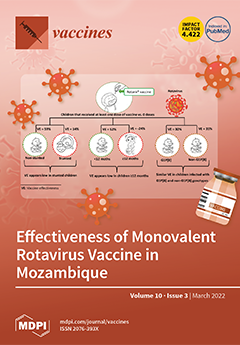The aims of the present investigation were (i) to determine psychological relapses of COVID-19 booster vaccine; (ii) to identify the determining factors affecting willingness to receive COVID-19 vaccine; and (iii) to study the relationship among emotional characteristics (anxiety, stress, depression, optimism), social media information, and the mandatory political choices (i.e., green-pass) in Croatian people. A cross-sectional online survey was conducted for 1003 participants (median age: 40 years) from Croatia during December 2021. Results showed a significant association between vaccinated and unvaccinated participants in all sociodemographic variables, except for gender (
p = 0.905). For psychological variables, significant differences were found only for levels of optimism (
p < 0.001). People with a postgraduate degree (OR: 2.25, [1.14–4.46],
p = 0.020) and PhD (OR: 1.97, [95% CI: 1.01–3.52],
p = 0.021) had higher odds of being vaccinated than participants with high school diplomas. Additionally, participants seeking information on TV and radio (OR: 2.35, [1.71–3.23],
p < 0.001) or from general practitioner (OR: 2.53, [1.78–3.61],
p < 0.001) had higher odds of being vaccinated. Conversely, participants seeking information on social networks (OR: 0.36, [0.27–0.49],
p < 0.001), general internet/blogs forums (OR: 0.34, [0.22–0.52],
p < 0.001), and from friends or acquaintances (OR: 0.66, [0.48–0.91],
p = 0.011) had lower odds of being vaccinated. Additionally, results showed that information policies have failed to fully convince the population to vaccinate and that depression (
p = 0.491), anxiety (
p = 0.220), and stress (
p = 0.521) were not determining factors leading to the decision to receive COVID-19 vaccine. Most of the vaccinated participants perceived the green-pass as potentially useful. In contrast, most unvaccinated participants believed that the green-pass is a form of discrimination and not useful (88%). Further and broader research into possible reasons for continuing or undertaking vaccination is needed. It is recommended to introduce a measure of conformism that represents a change of attitude, belief, or behavior in a narrower sense.
Full article






